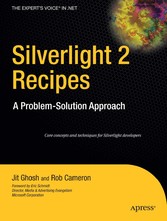Suchen und Finden
Contents at a Glance
5
Contents
6
Foreword
16
About the Authors
18
About the Technical Reviewer
19
Acknowledgments
20
Introduction
21
Who This Book Is For
21
How This Book Is Structured
22
Prerequisites
22
Downloading the Code
22
Contacting the Authors
22
A Quick Tour of Silverlight 2 Development
23
1-1. Setting Up the Silverlight 2 Environment
26
1-2. Integrating the Silverlight 2 SDK Documentation
27
1-3. Understanding the Structure of a Silverlight Solution
27
1-4. Understanding the Developer/ Designer Workflow
35
1-5. Understanding the Basics of Expression Blend 2 SP1
39
1-6. Accessing Source Control
45
1-7. Running Silverlight 2 on a Mac
45
1-8. Running Silverlight 2 on Linux
46
Application Design and Programming Model
47
2-1. Adding a Custom Class
48
2-2. Adding a Custom Control
53
2-3. Using the FindName Method
56
2-4. Dynamically Loading XAML from JavaScript
60
2-5. Dynamically Loading XAML from Managed Code
65
2-6. Persisting Data on the Client
66
2-7. Opening a Local File from a Silverlight Application
72
2-8. Accessing XML Data with an XmlReader
76
2-9. Accessing XML Data with LINQ
79
2-10. Managing Unhandled Exceptions
83
2-11. Executing Work on a Background Thread with Updates
85
2-12. Updating the UI from a Background Thread
94
2-13. Managing XAML Resources
98
2-14. Managing Embedded Resources
103
2-15. Creating Silverlight Ruby, Python, or JScript
107
Developing User Experiences
112
3-1. Importing from Expression Design
113
3-2. Working with Color and Gradients
115
3-3. Positioning UI Elements with a Canvas
124
3-4. Positioning UI Elements with a StackPanel
127
3-5. Positioning UI Elements with a Grid
131
3-6. Using Shapes to Draw
136
3-7. Using Paths to Draw
141
3-8. Using Geometries to Draw
147
3-9. Providing Scrollable Content
152
3-10. Applying a Border to Elements
154
3-11. Using Simple Animations with Objects
159
3-12. Animating UI Elements with Keyframes
166
3-13. Transforming an Object
176
3-14. Creating a Simple Cartoon Scene
181
3-15. Handling Keyboard Input
191
3-16. Working with Ink
197
Data Binding
203
4-1. Binding Application Data to the UI
203
4-2. Binding Using a DataTemplate
210
4-3. Receiving Change Notifications for Bound Data
217
4-4. Converting Values During Data Binding
230
4-5. Validating Input for Bound Data
241
Controls
255
A Word About the Samples
256
5-1. Customizing a Control’s Basic Appearance
256
5-2. Replacing the Default UI of a Control
258
5-3. Customizing the Default ListBoxItem UI
273
5-4. Displaying Information in a Pop-up
281
5-5. Displaying Row Details in a DataGrid
291
5-6. Applying Custom Templates to a DataGrid Cell
300
5-7. Creating Custom Column Types for a DataGrid
305
5-8. Creating a Composite User Control
312
5-9. Creating a Custom Layout Container
324
5-10. Creating a Custom Control
337
5-11. Defining a Custom Visual State
349
Browser Integration
360
6-1. Hosting Silverlight in HTML on Any Platform
360
6-2. Hosting Silverlight in ASP.NET
365
6-3. Setting Focus for Keyboard Input
367
6-4. Implementing a Full-Screen UI
373
6-5. Calling a JavaScript Method from Managed Code
380
6-6. Calling a Managed Code Method from JavaScript
388
6-7. Exchanging Data between Multiple Plug-ins
399
6-8. Embedding Silverlight within a Vista Gadget
404
Networking and Web Service Integration
419
A Quick Word About the Samples
420
7-1. Consuming a WCF Service
420
7-2. Exchanging XML Messages over HTTP
439
7-3. Using JSON Serialization over HTTP
450
7-4. Accessing Resources over HTTP
455
7-5. Using Sockets to Communicate over TCP
477
7-6. Enabling Cross-Domain Access
505
Integrating Rich Media
509
8-1. Adding Video to a Page
509
8-2. Creating a Complete Video Player
514
8-3. Adding Streaming Media Support
541
8-4. Using Playlists to Package Media
575
8-5. Using Markers to Display Timed Content
581
Index
596
Alle Preise verstehen sich inklusive der gesetzlichen MwSt.















